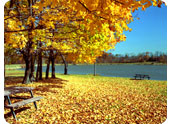DEMOGRAPHICS / CLIMATE
New Jersey Climate
New Jersey is located on the East Coast, with a geographic location influenced by wet, dry, hot, and cold airstreams that create highly variable weather. The state is only 166 miles long and approximately 65 miles wide, yet its regions experience marked differences in climate. Winter temperatures vary the most between the northern highlands and the central and south interior, while summer highs and lows are more constant. The state is divided into five climate regions:
Central Zone
Stretching from New York Harbor and the Lower Hudson River to the Delaware River near Trenton, dense development keeps urban areas warmer than the surrounding countryside. The northern edge of this zone is often the boundary between freezing and non-freezing precipitation.
Coastal Zone
Continental and oceanic influences create a variable climate with somewhat warmer fall and winter temperatures and often cooler spring temperatures than the interior. Sea breezes and coastal storms play a major role.
Northern Zone
Elevated highlands and valleys offer a continental climate with minimal ocean influence. Snowfall can average up to 50 inches.
Pine Barrens Zone
Scrub pine and oak forests dominate the interior south, where drier conditions create a wider shift between daily maximum and minimum temperatures.
Southwest Zone
Situated around sea level, this region in close proximity to Delaware Bay receives less precipitation than the Northern, Central, and Coastal zones and boasts New Jersey’s longest growing season.

